Tarzan the Ape Man (1959):
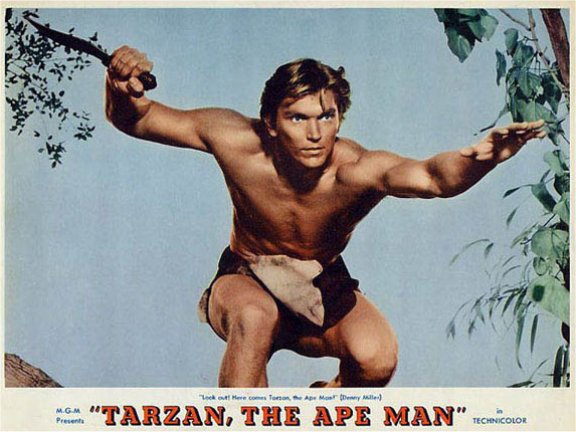
Tarzan and the Period Drama
By Quentin N Castle

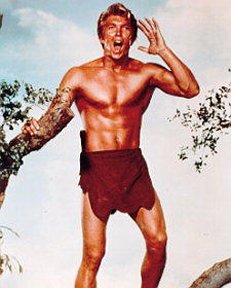 When one
thinks of a period piece certain names come to mind. Jane Eyre, Pride
and Prejudice, Sherlock Holmes and many of the other names of classic
English literature from the Victorian Era, or thereabouts, would probably
be on the list. However, it wasn't until 1959 that Tarzan also joined
these giants of period drama, a move that would prefigure much of the approaches
taken to the character on screen through the '80s and until the present
time.
When one
thinks of a period piece certain names come to mind. Jane Eyre, Pride
and Prejudice, Sherlock Holmes and many of the other names of classic
English literature from the Victorian Era, or thereabouts, would probably
be on the list. However, it wasn't until 1959 that Tarzan also joined
these giants of period drama, a move that would prefigure much of the approaches
taken to the character on screen through the '80s and until the present
time.
In 1958 producer Sol Lesser, who had owned the movie rights to the Tarzan
character since the early 1930s, decided to move on from producing the
screen adventures of the Lord of the Jungle. During a period of 10 years,
Lesser, for a fee, had allowed MGM to make their famous Tarzan series starring
Johnny Weissmuller.
In 1943 Lesser had continued making the series himself, initially with
Weissmuller, when MGM had decided to drop the series.
After producing 14 more Tarzan features, Lesser himself, after unsuccessfully
trying to bring Tarzan to television, now wanted to move on from producing
Tarzan. It was at this time that Lesser sold the rights to fledgling producer
Sy Weintraub, who promptly set about revamping the series to great success.
But MGM had plans of its own. After distributing the last two Lesser
Tarzan projects, MGM had renewed interest in the character it had brought
to the world of sound in 1932 and sought to make another feature of their
own before the rights changed hands. This decision did not please Weintraub,
who initially threatened litigation against MGM, however, the studio continued
to go ahead with their plans.
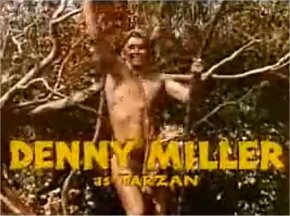 The new low budget
movie was to be produced by B movie specialist Al Zimbalist, famous for
classic B movies such as the Robot Monster (1953) and King Dinosaur
(1955). Zimbalist was in the process of producing a series of low budget
features set in Africa, utilizing footage from 1950's King Solomon's
Mines. Other films in this group were
Watusi (1959), a sequel
to King Solomon's Mines, and Drums of Africa (1963).
The new low budget
movie was to be produced by B movie specialist Al Zimbalist, famous for
classic B movies such as the Robot Monster (1953) and King Dinosaur
(1955). Zimbalist was in the process of producing a series of low budget
features set in Africa, utilizing footage from 1950's King Solomon's
Mines. Other films in this group were
Watusi (1959), a sequel
to King Solomon's Mines, and Drums of Africa (1963).
The new Tarzan film would also feature footage from King Solomon's
Mines and would be helmed by Joseph M Newman, director of the sci-fi
classic This Island Earth (1955). The production would be a remake
of the MGM hit, Tarzan the Ape Man (1932), which itself was a loose
adaption of the original Tarzan novel by Edgar Rice Burroughs. Although
a remake, it was the first time that the origin story of the Ape Man, at
least the origin of his discovery and relationship with Jane, was to be
shot in colour. Tarzan the Ape Man premiered in 1959, the same year
that Weintraub released his Tarzan's Greatest Adventure, starring
Gordon Scott in his fourth outing as the Ape Man.
In spite of its low production values, the movie featured a solid cast
that brought a sense of class to the proceedings. Up and coming actress
Joanna Barnes took the role of the world weary Jane Parker, who arrives
in Africa to meet up with her adventurer father, Col. James Parker (Robert
Douglas) when her finances, and fiancé, have run out. Italian actor
Cesare Donava brought a very European take to Harry Holt, Parker's business
partner and suitor for Jane's affections. The cast also features Thomas
Yangha as Riano, a Watusi who leads the Parker expedition to the legendary
Mutia escarpment, the gateway to the fabled elephant's graveyard.
However, the title role of Tarzan was given to contract player and UCLA
basketballer, Denny Miller, who, in his third acting role, would have the
distinction of being the first blonde Tarzan. Despite having little to
say, Miller had a great screen presence which enabled him to deliver a
likable performance as a strong, but endearing ape man. His portrayal of
Tarzan would also see the return of the classic MGM Tarzan cry which was
last used in Tarzan's New York Adventure (1942). The movie also
features an excellent jazz score by Shorty Rogers, that drives the movie
along, beautifully underscoring the exotic locations and action in the
film.
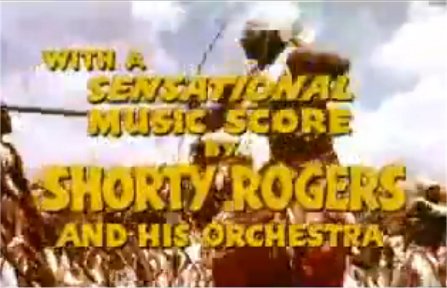
The plot by and large follows that of the original 1932 version. Jane
and company head off to climb the Mutia escarpment in order to locate the
elephants graveyard. On the way Jane meets Tarzan, who kidnaps the beautiful
stranger and takes her back to his tree house and ape family.
Tarzan, clearly taken with the strange female. eventually convinces
Jane that he means her no harm and receives his first lesson in the English
language. Eventually, while Tarzan is away, Jane is discovered by
Parker, Riano, and Holt, the latter shooting one of Tarzan's ape tribe,
and then firing at Tarzan upon his return.
As the expedition leaves, Tarzan follows the group over the escarpment
and arrives in time to rescue some of them from a savage tribe of pygmies
who are determined to sacrifice them to the fires of their horned God.
In the end only Holt, Tarzan and Jane survive to see the elephants graveyard,
with the latter two choosing to stay in the jungle together.
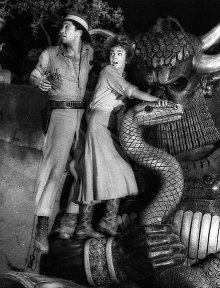 Only Holt leaves
the jungle, returning to civilization with his fortune in ivory. Unlike
the original, where the majority of the action, including the discovery
of Tarzan, takes place on top of the Mutia escarpment, the first half of
this movie is set in the low lands. Here the climbing of the Alps-like
escarpment marks the second stage of the narrative, which sees Jane and
the Parker expedition seek the elephant's graveyard and Tarzan, with some
help from Cheeta, seek the strange but beautiful stranger.
Only Holt leaves
the jungle, returning to civilization with his fortune in ivory. Unlike
the original, where the majority of the action, including the discovery
of Tarzan, takes place on top of the Mutia escarpment, the first half of
this movie is set in the low lands. Here the climbing of the Alps-like
escarpment marks the second stage of the narrative, which sees Jane and
the Parker expedition seek the elephant's graveyard and Tarzan, with some
help from Cheeta, seek the strange but beautiful stranger.
Much of the criticism levelled at this film is due to its use of stock
footage. Especially noticeable is the use of black and white footage from
Tarzan
the Ape Man (1932) and Tarzan and his Mate (1934). Although
attempts were made to make it blend in with the colour footage through
the use of colour tinting, the end result is at most times unconvincing
and jarring.
The use of colour stock footage, however, is a different matter. Footage
from King Solomon's Mines fits into the new movie seamlessly and if anything,
brings to the movie a bigger visual scope that it may not have had otherwise.
In order to assist in the combining of footage, the costumes from King
Solomon's Mines were duplicated for the characters of this film, an economical
decision that actually had the unintended effect of making this film an
important film text within the Tarzan corpus.
Until Tarzan the Ape Man, Tarzan had always been presented
as a modern character. Even the films that were released over the following
decade would work hard at establishing Tarzan as a character quite at home
in the world of the 1960s. But Tarzan the Ape Man is a period piece,
seemingly taking place, as King Solomon's Mines and the original
Tarzan novel does, near the turn of the last century.
This idea of Tarzan as a period character would eventually take root
during the 80s and 90s, when films like the next remake Tarzan the Ape
Man (1981), the Stanley S. Canter produced duo Greystoke: The Legend
of Tarzan (1984) and Tarzan and the Lost City (1998), the 3
Disney's Tarzan animated features, and Joe Lara's TV series Tarzan the
Epic Adventures (1996), all presented Tarzan as taking place during
the very early years of the 20th century. Even the most recent attempts
at bringing a new live action Tarzan feature to the screen seem to have
been toying with a period setting.
Far from being just another B jungle flick, Tarzan the Ape Man
is an enjoyable instalment to the series that, although suffering at times
from the limitations of its budget, presents some firsts for the series.
The most influential of these is the presentation of Tarzan and Jane as
period characters, an approach that has continued to flourish until the
present era.
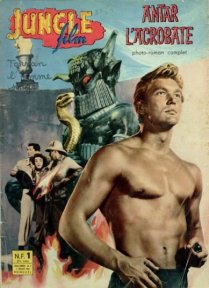 Last year
we saw the centenary celebrations of Tarzan of the Apes.
But the milestones for the character this decade are not over. 2018 sees
the 100th anniversary of Tarzan on film and to celebrate this milestone
I would love to see this movie, Tarzan the Ape Man, officially released
on DVD and finally given the treatment it deserves.
Last year
we saw the centenary celebrations of Tarzan of the Apes.
But the milestones for the character this decade are not over. 2018 sees
the 100th anniversary of Tarzan on film and to celebrate this milestone
I would love to see this movie, Tarzan the Ape Man, officially released
on DVD and finally given the treatment it deserves.
Just as Star Wars and some episodes of the classic low budget Sci-Fi
series Doctor Who have been given recent make overs, I would love to see
this movie attended to with some of the SFX healing power that digital
technology can bring. I would also like to see the black white stock
footage colourised, taking colour cues from the rest of the movie. I would
love to see the scenes featuring super imposition tinkered with digitally
to decrease the obvious contrast between the combined images. I would even
love to see the scenes with both black and white footage and colour super
imposition attended to.
Finally, as cute as it is, there's a certain rubber leopard that needs
to be replaced by footage of a real one. I know that this sounds like the
daydreams of a fan and to some may seem like trying to needlessly undo
history. However I have great affection for this movie and even the original
novel, Tarzan of the Apes had the opportunity to be revised,
seeing Sabor the tiger replaced with Sabor the lioness.
All I ask is that 1959ís Tarzan the Ape Man gets to have the
same opportunity.
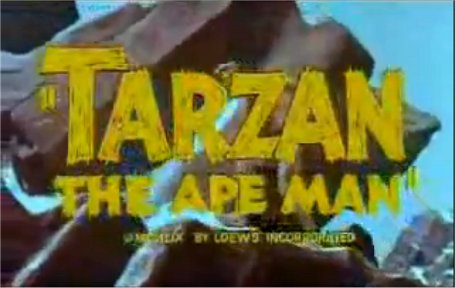


![]()
![]()
![]()
![]()
![]()
![]()

![]()